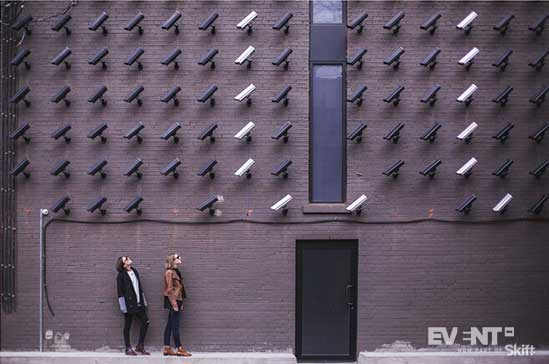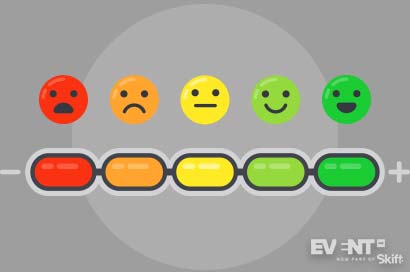Tracking attendee engagement and satisfaction is essential for creating a successful experience, but only 28% of planners measure it accurately or in detail. That’s not exactly surprising considering that only 48% of planners use technology to collect and analyze data. Surveys and questionnaires can help shed light on people’s motivations and feelings, but nobody cares about replying to the tons of emails coming from planners.
Some planners use apps strategically at the end of every session but it all inevitably ends in survey fatigue.
Enter emotion recognition.
Emotion recognition is a new opportunity for continuous analysis of attendee reactions throughout the event. In essence point a camera at people, let AI interpret their body language and boom, no need for surveys. Is it the end of surveys as we know them?
Not so fast.
There is a growing movement of event professionals and attendees against the use of facial recognition and facial analysis at events.
First things first, let’s take a look at what emotion recognition is and why it is so controversial.
Emotion Recognition, What Is It?
Emotion recognition is the process of collecting data predominantly from facial and verbal expressions to analyze human emotion. While humans do this all the time as part of our normal social interactions, “computational methodologies have also been developed” that utilize things like signal processing, machine learning, and computer vision to do the same thing. Wikipedia 2019.
It’s a form of artificial intelligence (AI) that aggregates a number of data points to figure out how you feel. And it’s pretty powerful stuff.
Human beings use a combination of signals to recognize the type of emotion another person is experiencing. These signals include facial and verbal expressions, body posture, but also context and cultural bias.
Scientists have developed techniques using AI software, to try and replicate the way humans detect emotions. These techniques supposedly allow machines to correctly analyze a person’s emotions and state of mind and possibly predict that same person’s future behavior. They mainly focus on facial recognition software.

What is emotional recognition for?
The Chinese government has been implementing emotion recognition to predict criminal behavior as part of a nationwide effort to increase surveillance efforts. The idea is that you can identify criminal suspects by analyzing in real-time their mental state (aggressiveness, stress levels, etc.) using video footage and emotion recognition technology. For the fans of Minority Report, there you go.
Apart from its application in surveillance, emotion detection technology can be used in fields as different as market research (to determine how customers feel about a brand or a product), healthcare (to help medical professionals assess the wellbeing of patients), the automotive industry (to monitor and detect driver impairment in smart cars), or video games (to test user experience). (Source The Guardian).
The Controversy: Are You Ready for Your Close-up?
The use of emotion recognition is controversial mainly because of the privacy concerns it raises, and the potentially harmful applications it can have.
For some, it’s the fear of entering an Orwellian Big Brother era, where police and national intelligence agencies can surveil the whole population and target certain populations.
For others, it’s imagining a world where everybody is aggressively and constantly targeted by commercial entities who want to sell their services or products.
Some have taken steps to resist the use of such technologies. For example, cities like San Francisco and Oakland, CA are banning the use of facial recognition by the city government, and 40 music festivals have pledged to ban facial recognition systems.
On the other hand, emotion recognition supporters rave about the opportunities it can bring, such as improved security through constant scanning of crowds for criminal elements, faster processing at airports, and speedier check-in at events, hotels, etc.
So what are the pros and cons of emotion recognition methods?
Pros
- The technology isn’t physically intrusive; using facial recognition doesn’t require any sensors attached to the person.
- It allows for the passive collection of often-hard-to-measure engagement and sentiment data at all times, providing real-time feedback.
- No expensive hardware is required; standard cameras are normally fine.
- It can potentially represent a cost-savings as less temporary staff is needed at check-in, for example.
- It could be very promising in certain fields of healthcare. For example, it could assist with the diagnosis of people with disorders like autism and schizophrenia by measuring how they read emotions in real-time.
Cons
- Data protection and privacy concerns need to be addressed, as with any other technology that combines surveillance with potentially personal data.
- Research has shown that facial recognition often misidentifies people of color and people whose gender representation differs from the binary norm. Implementation might, therefore, contribute to racial and gender profiling.
- A new review of research on emotional recognition shows that using only facial analysis to infer emotion might prove inaccurate: emotional expressions are typically very nuanced, subtle, and expressed in a variety of ways, which makes it hard to reliably deduce how someone feels by simply relying on facial movements.
- To get a more accurate picture, different sets of metrics might need to be combined, which would increase complexity and cost. Some companies look into metrics involving speech analysis, gait analysis, and eye-tracking methods. But context and cultural differences should also be considered in order to get a more reliable picture and determination of emotion.
- There is the potential of abusing such technology in a way that would violate our sense of personal privacy, and thorough regulation may be required before we feel comfortable allowing our faces to be scanned and analyzed.
How Event Professionals Can Use It
People are getting more familiar with facial recognition technology. We already use it to unlock our phones or go through security at airports. The events industry is getting on-board.
Facial recognition and analysis is already facilitating and speeding up check-in operations, and providers are taking lengthy measures to respect data regulations and attendees’ privacy in general.
The emotion recognition side of AI still needs to pass a few hurdles, but it’s very compelling nevertheless. The potential for optimizing the attendees’ experience by providing a more accurate way of measuring people’s satisfaction with different elements of the event is something we should all be paying attention to.
Facial recognition cameras are already used in events to collect sentiment data. They are capable of assessing how ‘happy’ a person is based on subtle, distinct features of their face. Because facial recognition software can process thousands of faces almost instantaneously, you can get real-time ‘happy maps’ that allow you to see which areas/booths/sessions get people the most engaged.

DITCHING EVENT SURVEYS FOR GOOD?
Understanding the impact and reception of specific event elements will prove immensely valuable to event planners, as that data will inform what to invest in from event to event. But the real-time potential is also very promising. Detecting places and activities that make people ‘unhappy’ in real-time would allow organizers to investigate and address problematic situations immediately, guaranteeing an overall better event experience.
Other options for collecting sentiment and engagement data include surveys and questionnaires, which people are notoriously reluctant to fill in, and wearables, which can provide extremely valuable data but require attendees to physically carry or wear something around the event with them. It will be very interesting to see how emotion recognition through facial recognition evolves and compares in both utility and cost.
WILL EMOTION RECOGNITION AT EVENTS WORK?
This is, of course, provided everything works perfectly. And we are not necessarily there. Despite the marketing claims of many companies, we may still be far from 100% bulletproof implementation.
We are still in an industry where wifi hardly works. We are also in an industry where 2 years ago AI could process hundreds of instances at a time, today that limit is completely gone. Things are slow, but super fast. With 5G getting into the game, we can anticipate data collection not to be an issue.
BUT WHAT ABOUT THE DATA?
What if I am sneezing? Does it mean that I didn’t like the session I am attending? A couple of years are needed to make sure the technology becomes smart (or creepy) enough to really understand what’s going on.
PRIVACY IS BECOMING CURRENCY
Attendees are taking ownership of their privacy. At a recent event, one attendee came to me and asked me for an alternative way to access event information as they did not want to give reading/writing access to the app on their phone.
We can anticipate more privacy initiatives soon regulating facial analysis too. With Europe out of the infancy of GDPR and California just about to embark (January 2020) in its California Consumer Privacy Act (CCPA), privacy is going to remain a hot topic for event professionals.
Confusion is dominant with planners left in the hands of suppliers that promise security but are often times caught up in widespread data breaches.
It’s a ‘handle with care’ item for now.
If you decide to implement facial analysis, you will need to work with your provider to cover at least the following:
- Offering opt-in/opt-out options
- Securing and recording the consent of each participant
- Explaining clearly what you plan to use the technology and the data for
- Ensuring the security of data through the use of local servers
- Protecting the privacy and security of attendees in accordance with regional laws and regulations
- Ensuring the appropriate disposal of data after the event

IN CONCLUSION
There is no such thing as intrinsically good or bad technology. It’s about how we use it.
Emotion recognition could represent an unprecedented opportunity for event professionals to improve event experiences for their guests by acknowledging their feelings and reactions in real-time, addressing any bottlenecks onsite, and tracking the popularity and engagement of specific event elements for a richer ROI analysis.
But, as always, it is incumbent on us as event professionals to be mindful of the problems associated with any new technology, and to guide and educate people who may be resistant to it.





